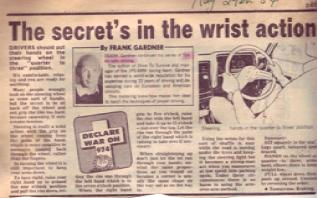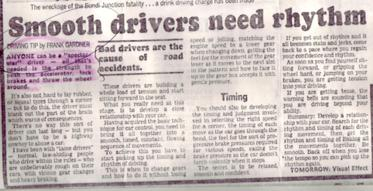Road
Safety
Driving Tips
"Peace of mind isn't expensive" - the role of maintenance
I am talking about the everyday active family hack that is allowed it become tired and run-down, and nobody wants to spend time and money to get it back in shape.
The car might have some slack in the steering but still goes round corners.
The brakes might be a bit uneven and make take a little longer to wash off speed, so you don’t drive so fast.
The tyres are on the lean side, the shock absorbers are tired – and so it goes on.
Each item alone doesn’t seem to pose much of a threat but when brought together in some sort of crisis the odds of getting out are very much against you.
What many people forget is that you only need a metre less stopping distance and a few centimeters more accuracy to avoid this problem.
Apart from that it is not a bad idea when you buy your first car or change cars to allow some time to familiarize yourself with the location of the various controls and how to work them.

"Think fast before halting on road" - make sure you think before pulling over
If you happen to strike mechanical trouble it’s a good idea to have a quick think before you pull over. Perhaps the engine is missing and dying on you or some strange noise has developed – work out where you are going to check it while you still have some forward momentum.
It is preferable to simply jump on the brakes and find yourself in a vulnerable place where you are unable to leave.
Always put your hazard warning lights and raise your bonnet, even if the problem is elsewhere, because some kind soul who knows more about cars than you might be tempted to stop.

If the car is liable to surprise other people coming over a hill or round a bend it’s best to send a passenger back to slow these other cars down.
All passengers should get out of a dangerously placed car so you might as well give them something worthwhile to do.
If you are alone, place a warning triangle over the hill or round the bend – on the hard shoulder.
There is also a trick some police forces use when their highway patrol person books you that you could adopt if you ever pull up to help a stranded driver.
They park behind the car and out from the kerb to give a little working space to the troubled motorist.
"The Secret is in the Wrist Action" - the role of the steering wheel
Drivers should put their hands on the steering wheel in the “quarter to three” position. It’s comfortable, relaxing and you are ready for anything.
Many people wrongly look on the steering wheel as some sort of handle, but the secret is to sit back off the wheel and not grip the rim too hard because squeezing it only creates tension.
Steering is really a wrist action with the grip on the wheel coming from the palm of the hand, which is more sensitive to the messages coming back through the wheel, rather than the fingers.
In turning the wheel it is still important to keep your arms down.
To turn right, raise your right hand around the 1 o’clock position and pull the rim down, letting the rim run through the left hand which is in the 7 o’clock position.
When the right hand gets to the 5 o’clock, raise the rim with the left hand and take it up to 11 o’clock – not over the top. Let the rim run through the palm of the right hand which is raising to take over if necessary.
When straightening up don’t let the lot run through your hands; unwind the same proportions as you wound on because a corner is usually the same shape on the way out as on the way in.
Using the wrists for this sort of shuffle is easy while the road is moving under the tyres and keeping the steering wheel light but it becomes a strong man act when you manoeuvre at low speed into parking lots. Under these circumstances there is no harm in using the arm over arm method.

SUMMARY:
Sit squarely in the seat. Legs apart, balanced and braced.
Hands on the wheel at quarter to three, arms bent, elbows down to keep weight low.
Pull wheel down first, push up second. Unwind by reversing the order.
"Smooth Drivers need rhythm" - taking care of your car through driving technique
Anyone can be a “spectacular” driver – all that’s needed is the strength to push the accelerator, lock brakes and throw the wheel around.
It’s also not hard to lay rubber, or squeal tyres through a corner – but to do this, the driver must blank out the part of the brain that warns of consequences.
There’s no way this sort of driver can last long – but you don’t have to be a highway cowboy to abuse a car.
I have been with “tame drivers” – normal people who drive within the rules – who are unbelievably rough on their cars, with vicious gear changes and heavy braking. These drivers are building a whole lot of tension and start sitting forward in the seat.
What you really need at this stage is to develop a close relationship with your car.
Having acquired the basic technique for car control, you need to bring it all together into a smooth, timed, constant, flowing sequence of movements.
To achieve this you have to start picking up the timing and rhythm of driving.
This is when to change gears and how to do it without loosing speed or jolting, matching the engine speed to a lower gear when changing down, getting the feel for the movement of the gear lever as it moves to the next slot in the pattern and how to face it up so the gear box accepts it with gentle pressure.

SUMMARY:
Develop a relationship with your car. Search for the rhythm and timing of each driving movement, then get the rhythm and timing of linking all the movements together. Be smooth. Back off when you lose the tempo so you can pick up the rhythm again.
TIMING:
You should also be developing the timing and judgement involved in selecting the right speed for a corner, the timing of each move as the car goes through the bend, the feel for the sort of progressive brake pressure required for various speeds, easing the brake pressure so the car doesn’t lurch violently when it stops.
The secret is to be relaxed.
If you get out of rhythm and it all becomes stabs and jerks, come back to a pace where you regain your confidence and rhythm.
As soon as you find yourself sitting forward, or gripping the wheel hard, or jumping on your brakes, you are getting tension into your driving.
If you are getting tense, the warning bells are sounding that you are driving beyond your ability.
"Concentrate on one thing at a time" - itemising what is going on around you
People who often offer advice on driving say motorists should concentrate more and it sounds like a lot of hard work and not very much fun.
But concentration means nothing more than giving your attention to one activity at a time. In the sphere of driving, concentration is the ability to itemise what is going on around you.
To achieve this, think of the windscreen of your car as a wide angle TV screen in true to life colour which you are scanning for a flow of information.
If you’re new at driving or haven’t really given this kind of approach much thought, a helpful way of picking up the threads of this technique is to talk your way, out loud, through something like a shopping centre or busy street in a commentary of what is going on.
Obviously, the view ahead should get the lion’s share of your attention, but people seem to forget that what is going on behind is extremely important.
So you should be regularly monitoring the rear vision mirrors as often as a quick glance every 10-15 seconds.
What is really important is that you must not allow yourself to be distracted from monitoring this information flow.
Download
word document
SUMMARY:
Go after prevention rather than cures. Monitor the flow of information likely to affect your passage along the road. Make up commentary to get the idea of the technique. Check your mirrors every 10-15 seconds.
"Going around the bend" - points to watch
Cornering is one of the riskier moments in driving, mainly because a car’s road holding abilities depend largely on where designers have put the engine.
If it is mounted in the front, the sideways force in cornering is going to be concentrated at the front – because that’s where most of the weight is.
A rear-engined car, on the other hand, is more prone to “hanging its tail” because the back tyres grip on the road is subject to a greater sideways force from the weight of the engine.
In both cases, that moment when the tyres lose their grip is the one when someone’s life is in danger.
Naturally, the heavier the engine the more pronounced the effect and a big cast-iron V8 planted well forward under the bonnet can have disastrous effects on a car’s road-holding ability.
The same sort of problem can be found where a car maker mounts a six-cylinder engine in a vehicle designed for a four-cylinder drive.
Being so far forward, this longer, heavier engine is prone to ploughing on in a corner because the tyres are having such a hard job coping with the concentration of weight.
The ideal set-up is with the engine at the front and the gearbox hung down the back with the differential – which achieves a near perfect balance between front and rear.
But this is an expensive solution, found in only a few volume-selling cars.
Sums for efficient braking